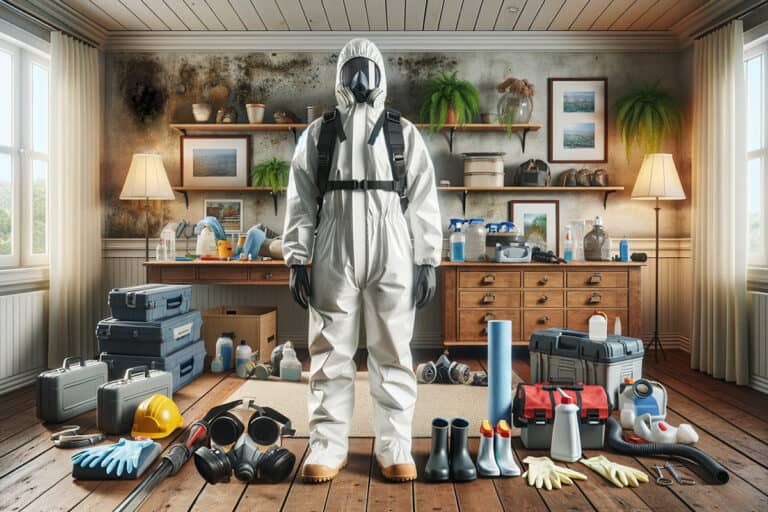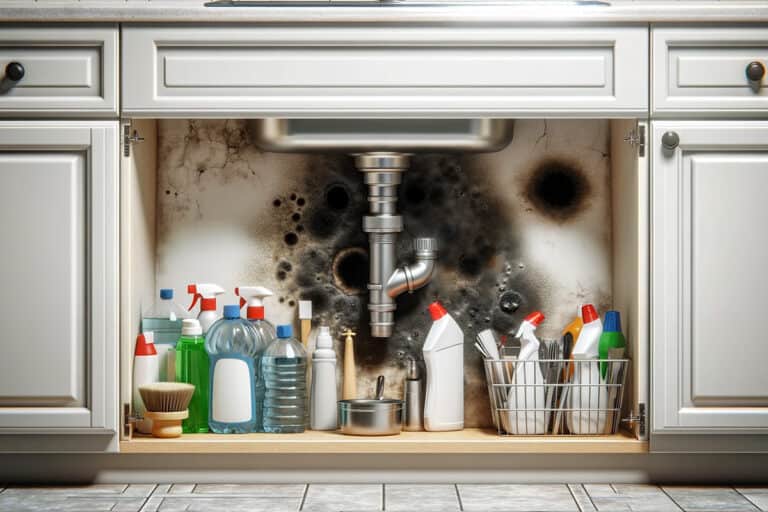Disclosure: I am compensated for purchases made through some links on this site. Click for details.
Yellow mold is a common yet potentially perplexing substance that can be found in various domestic and outdoor environments. Characterized by its distinct yellow color, it’s a type of fungus that thrives on moisture, oxygen, and organic matter. Recognizable for its texture and hue, yellow mold can grow on a multitude of surfaces, ranging from wooden structures to textile fabrics, often indicating an underlying moisture problem.
Identifying and understanding yellow mold is essential, not only because of its ubiquity but also due to the health implications it can carry. Certain species of yellow mold, such as some forms of Aspergillus, are known to be present in households and can cause health issues if not addressed properly. Safe removal and appropriate cleaning techniques are critical to control and prevent mold-related problems, ensuring healthy living conditions.
Key Takeaways
- Yellow mold is a moisture-loving fungus recognizable by its color and texture.
- Yellow mold can pose health risks and indicates excessive moisture.
- Proper identification and removal are essential for a healthy environment.
Basics of Yellow Mold
Yellow mold is an umbrella term that typically refers to various species of mold with a yellow coloration. These molds can be found both indoors and outdoors, growing on a variety of organic substances, particularly in damp and dark environments.
Identification and Characteristics
Yellow mold, often exhibiting a dusty or fuzzy appearance, may also present as a yellow slime mold with a distinctive gelatinous texture. Commonly encountered strains include Aspergillus and Cladosporium, which, despite their different taxonomic classifications, may sometimes appear yellow under certain conditions. Aspergillus is particularly known for its potential to cause allergic reactions and respiratory issues in sensitive individuals.
Types of Mold Similar to Yellow Mold
While yellow molds can vary in type, many species referred to as yellow slime mold belong to the group known as slime molds, which are technically not fungi but protists. They differ from other types of mold such as the ubiquitous Stachybotrys, often called black mold, which is usually associated with a high level of toxicity. It is crucial to correctly identify these types to understand the potential risks and appropriate removal strategies.
Causes and Growth Conditions
Yellow mold thrives in environments where moisture and organic materials are abundant. Understanding the specific causes and growth conditions is essential for preventing and addressing these infestations.
Moisture and Humidity Factors
Elevated levels of moisture are prime contributors to the proliferation of yellow mold. Areas with persistent humidity or that experience water damage provide an ideal breeding ground. Poor ventilation can exacerbate these conditions, particularly in damp areas of a home or building, such as basements and bathrooms, where air does not circulate well and moisture cannot escape.
Common Locations and Materials
Yellow mold is frequently found on wood, which is a favored food source due to its porous nature. It often appears in kitchen areas where spills and splashes are common and in bathrooms due to steam and condensation. Drywall and walls in general can harbor mold if exposed to moisture, as can other cellulose-rich materials found in many homes, especially if they have been softened by water damage.
Health Implications of Yellow Mold
When discussing yellow mold, it is important to understand that exposure can lead to various health implications, predominantly respiratory issues and allergies. These complications may range from mild allergic reactions to more severe health risks, especially in individuals with compromised immune systems.
Allergies and Respiratory Effects
Yellow mold exposure can trigger allergic reactions, such as sinus issues, coughing, and itchy skin and eyes. Individuals with sensitivity to mold may experience respiratory problems including wheezing, asthma, and shortness of breath. For those with mold allergies, the presence of yellow mold spores can lead to exacerbation of allergic reactions, causing discomfort and potentially affecting their quality of life.
Serious Health Risks
Beyond allergies, yellow mold can produce mycotoxins, which are potentially toxic substances that can pose serious health problems. Long-term exposure to these mycotoxins may weaken the immune system, leaving an individual more susceptible to infections. In severe cases, exposure to toxic mold can result in symptoms like fever, persistent headache, and can even exacerbate chronic respiratory conditions such as tuberculosis and other respiratory diseases.
Prevention and Control
Effective management of yellow mold includes both prevention strategies and control measures to address existing growth. Implementing certain household tips can keep mold at bay, while professional remediation ensures the safe and thorough removal of existing infestations.
Household Prevention Tips
Temperature and Humidity: Maintaining indoor temperatures below 77 degrees Fahrenheit and using a dehumidifier to keep humidity levels under 55% can prevent yellow mold growth.
Ventilation: Ensuring proper ventilation, especially in high-moisture areas like kitchens and bathrooms, is critical for maintaining good air quality and hindering mold development.
Regular Cleaning: Routine cleaning and prompt attention to water leaks or spills can prevent mold spores from settling and proliferating.
Professional Remediation Processes
Safety Precautions: Remediation professionals will begin by taking safety precautions, including the use of gloves, goggles, and masks, to protect themselves and prevent mold spore dispersal.
Isolation and Ventilation: They isolate the affected area and may use fans or open windows to improve ventilation during the removal process.
Mold Remediation: Specialists employ advanced techniques and equipment to thoroughly clean and treat areas affected by yellow mold, ensuring complete removal and minimal risk of recurrence.
Cleaning and Removal Techniques
When addressing yellow mold, one must employ effective cleaning methods and sometimes consider professional mold removal services. Proper treatment begins with safety and ends with a mold-free environment. It’s crucial to perform an inspection prior to any treatment to assess the extent of the mold issue.
Home-Based Methods
For minor mold problems, one can use a bleach solution comprising of one part bleach to three parts water. This solution should be applied to the affected areas, allowing it to stand for approximately 10-15 minutes before scrubbing away the mold. It’s imperative to wear protective gear, including gloves, goggles, and a mask, to prevent inhaling or coming into direct contact with mold spores.
A regular cleaning schedule can prevent mold from recurring, with attention to moisture-prone areas to maintain a mold-free environment. If molds like slime mold are found on lawn mulch or in similar areas outside, they can often be removed by adjusting the landscape to reduce moisture and enhancing air circulation.
When to Call Professionals
The presence of extensive mold, or if yellow mold is found within HVAC systems, often necessitates professional mold removal. Professionals possess the expertise to conduct a thorough inspection and deploy advanced techniques for mold treatment, ensuring complete eradication. If someone is experiencing health symptoms due to mold exposure, it’s especially important to consult professionals to handle the situation safely.
Identifying and Addressing Infestations
When dealing with yellow mold, recognizing its presence and taking decisive action are critical to maintaining a healthy environment. A thorough inspection can reveal an infestation, and understanding the necessary steps to address it helps to quickly mitigate the issue.
Inspection and Detection
Detecting yellow mold typically involves looking for visual signs or sensing a musty odor, especially in areas prone to moisture like attics, basements, and crawl spaces. During an inspection, one should search for yellow discolorations or spotty coatings on surfaces, especially in damp areas where spores may thrive due to leaks or poor ventilation. Indications of yellow mold can vary from pale to bright yellow patches and might appear slimy or powdery. If suspected mold is found, it’s recommended to seek out a professional assessment to confirm its presence and identify the species, as some types of mold can be harmful.
Steps After Discovery
After confirming an infestation, the immediate step is to address any water problems contributing to the mold’s growth. This can involve repairing leaks, ensuring proper ventilation, and keeping the affected areas dry to prevent further spore proliferation. Items that cannot be thoroughly cleaned must be removed and replaced to prevent mold from spreading to other parts of the building.
When cleaning mold from surfaces, it’s important to wear protective gear and use appropriate cleaning solutions. For extensive infestations, particularly in large buildings or within critical spaces like attics or crawl spaces, consider hiring mold remediation specialists to get rid of the mold safely and effectively.
Conclusion
Yellow mold… this common yet potentially harmful fungus requires vigilant attention and proper management to safeguard your health and maintain a healthy living environment. Yellow mold, with its distinct color and preference for moist conditions, poses not only a risk to structural integrity but also to human health, particularly through respiratory issues and allergic reactions. Understanding its characteristics, growth conditions, and health implications is crucial for effective identification, prevention, and control.
Prevention strategies, including maintaining low humidity levels, ensuring adequate ventilation, and regular cleaning, are pivotal in mitigating mold growth. For instances where mold has already taken hold, employing proper cleaning techniques and, when necessary, professional remediation services, ensures the thorough removal of mold and minimizes the risk of recurrence.
Ultimately, awareness and proactive measures are key to managing yellow mold infestations. By identifying potential problem areas early, addressing moisture sources, and adhering to effective cleaning and removal practices, individuals can protect their homes and health from the challenges posed by yellow mold. Whether tackling minor occurrences with home-based methods or seeking professional assistance for extensive infestations, the goal remains the same: to create and maintain a mold-free, healthy living environment.


